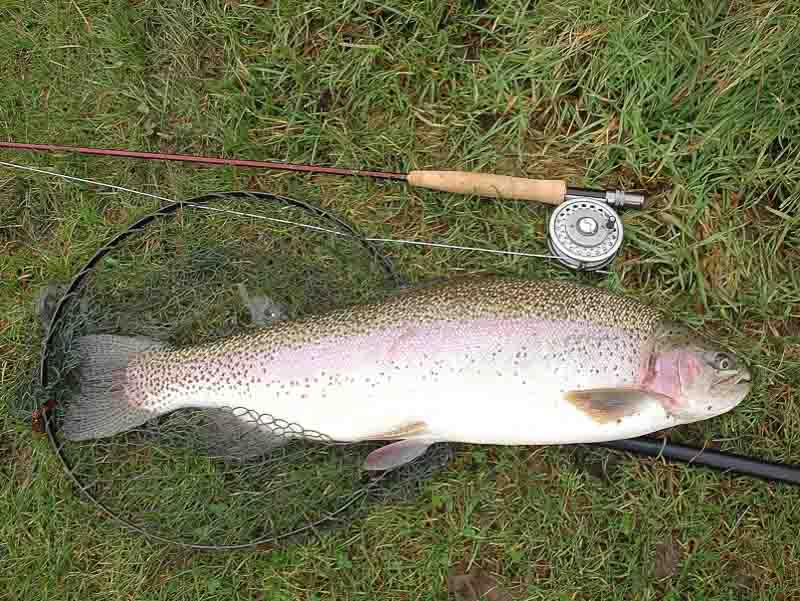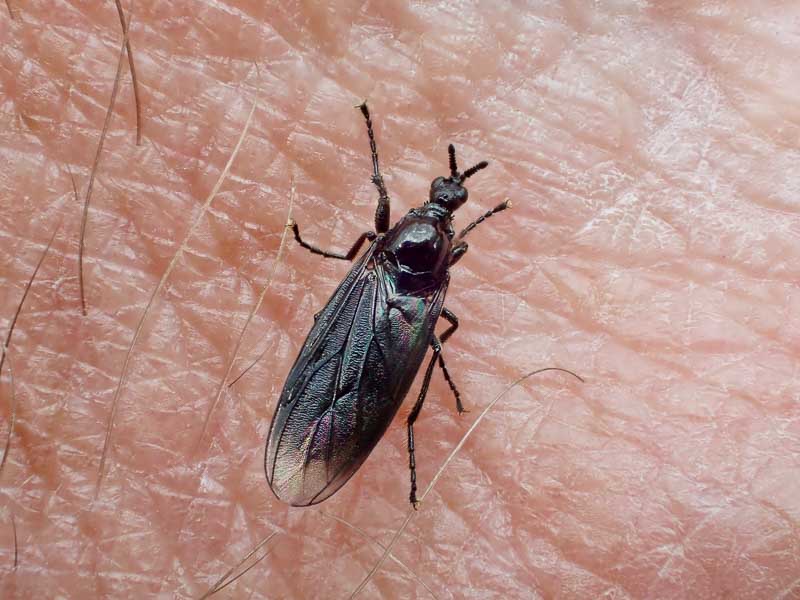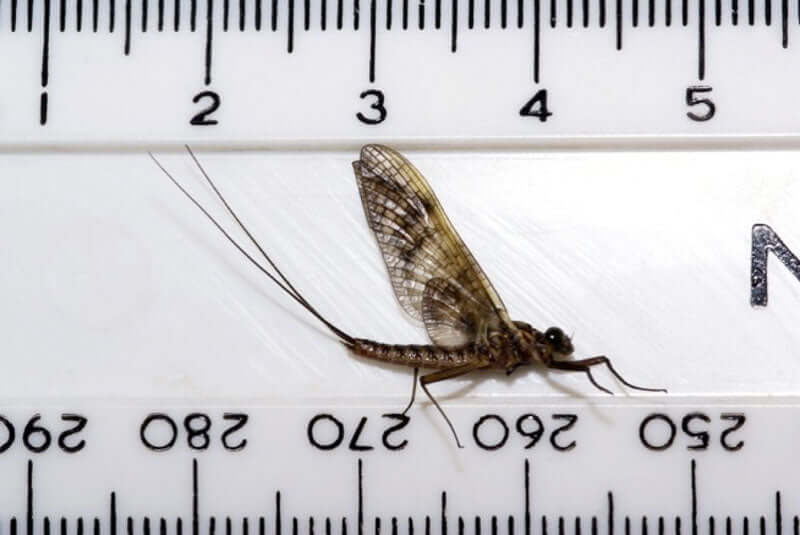by Dave Southall
I have long been an advocate of light lines (1 up to 3 weight) teamed up with light, soft actioned rods, often teamed up with tiny flies & light tippet. Some folks believe that such tackle is unsuited to the capture of big fish, either because it is not strong enough to subdue such fish or because it involves excessively long battles that overexert the fish leading to toxic buildups of lactic acid & subsequent fish mortality. Whilst I agree that there is a limit to how light one can sensibly go in some situations, particularly with big fish in snaggy places or very fast flows, my experiences in most cases do not support their views.
I have easily landed rainbow trout up to just short of 14lb from my local small still water with a 10’ 4 weight rod & 5x tippet as the water has no snags & is well oxygenated being fed from the cool, oxygen-rich waters of local chalk stream. From the same small lake I have landed rainbows to 5lb 14oz on a 10’ 6”, very soft, Sunray Zero weight rod teamed up with 7x tippet & a size 30 Buzzer. On my local chalk stream, Driffield Beck I have landed trout to over 5lb & chub to 4lb 9oz on a 1 weight setup & 5x tippet without any significant problems. Long, soft rods absorb any sudden shock-loads whilst playing a big fish, particularly if it bolts or thrashes at close quarters.
As a result there are far fewer breakages & less hooks & tippet left in fish. Whilst barbless hooks left in a fish should, in theory, soon become dislodged this is not always the case: a few years ago a friend snapped-off on a trout whilst using my rod & over a week later I caught the same fish with my barbless hook & a length of tippet still firmly attached. Many of the big fish that I catch are feeding on tiny food items, Midges, Aphids & particularly Agapetus Sedge Pupae & this requires light tippets, typically 6 & 7x & a long, soft rod of no more than 3 weight is essential to avoid breakages.

- A double figure rainbow caught on a 10’ 4/5 weight rod, 5x tippet & a Bloodworm. It was successfully returned to the water alive after a very quick photo.
So what about the argument that light gear leads to overplaying of big fish & their subsequent death due to lactic acid buildup? This used to be my fear & I still use as strong a tippet as I feel that I can get away with. I have found out that in most situations soft rods do not necessarily lead to protracted fights with big fish that result in highly stressed fish. Lactic acid only builds up during anaerobic respiration that only occurs during vigorous exercise when the oxygen supply is inadequate to facilitate aerobic respiration.
This build up will therefore only occur if the fish is fighting very hard & particularly if the water is warm & therefore unable to dissolve much oxygen or if there is a high level of organic waste in the water which results in a high BOD (Biological Oxygen Demand from aerobic respiration of microorganisms feeding on the organic waste) resulting in water that is not fully saturated with dissolved oxygen. Fish do not seem to fight as hard with soft rods, probably because they do not feel sudden, sharp limits to their freedom to move. In fact I have sometimes slackened off the pressure on a big fish heading for snags only to find that it has calmed down & started to behave as though it hadn’t been hooked. I discovered this when by chance I hooked an oversized rainbow on light, fixed-line Tenkara gear in Austria. I should add that I do not advocate the use of fixed-line Tenkara gear when fishing for big fish as there is too much risk of breakages & leaving hooks in fish. However, a 10’ 6 to 11’ 6” Sunray Zero weight rod with a reel & with a superlight Fluorocarbon Tenkara line is a good alternative to Tenkara where oversized fish live in the maelstrom that is a typical alpine stream such as the Villgratenbach in Austria where Tenkara style fishing is the only truly viable method of presenting a fly effectively.
The fight with soft rods may take a little longer, although I’ve not found much difference when compared with all but mega-heavy gear strong enough to drag a fish to the net, but the fish will actually be less stressed as the gentler fight will have produced much less lactic acid.

- 5lb 0oz Driffield Beck trout caught on an 8’ Orvis 1 weight rod & size 20 Elk Hair Caddis. Photos. Showed that his fish was re-caught at least 5 times over the following 3 years.
Lack of oxygen is the real problem for fish during & after the fight. Lack of dissolved oxygen can be a significant problem in lowland lakes in warm summers when thermal stratification results in a layer of warm, less dense water (the epilimnion), floating on the surface & separated from a lower layer of cooler, more dense water (the hypolimnion) by a narrow zone of steep temperature drop (the thermocline). In rich (eutrophic), shallow lakes the water of the hypolimnion can become completely depleted of oxygen late in the summer as there is virtually no intermixing of surface & lower water layers. In rivers low oxygen levels are only likely to become a problem during very hot drought conditions in eutrophic sections of river below the headwaters or in waters with little tree-cover. Spring-fed streams such as chalk streams that are fed with water at a constant 10 degrees C virtually never suffer from low oxygen levels caused by high water temperatures, the only exception being if the springs dry up.
The biggest danger to big fish that have fought hard is removal from the water. If the following procedure is adhered to then there should be no problem with survival after catch & release:
- Always use a net so the fish can be restrained as soon as possible during the fight.
- Leave the fish in the net, in the water, until the fish has had some time to recover.
- Ideally unhook the fish whilst it is in the net, in the water, (I use a floating net when I’m wading).
- If the fish has to be unhooked on the bank remove the hook as quickly as possible.
- If photos are to be taken have the camera set & ready to shoot whilst the fish is recovering in the net, in the water.
- If possible take any photos with the fish in the water.
- If the photos cannot be taken with the fish in the water take one very quick shot. If in doubt DO NOT TAKE A PHOTO.
- Do not release a fish from the net, or from a gentle but secure cradling grip whilst holding the fish facing the current to help it recover, until you are absolutely sure that it is fully recovered & isn’t going to go belly up soon after release.

- Ideally take a photo whilst the fish is in the water or only very briefly removed gently.

- Photo taken whilst slipping the fish back from a floating net
Whilst most of my trout & grayling fishing is carried out with super-light setups in a very overgrown section of my local beck with a mass of willows growing in the river I fish a large Elk Hair Caddis at dusk with a poky 9’ 6 weight rod & 3x tippet when targeting the big wild trout that live there. Super-light gear is much more pleasant to use, spooks less fish & facilitates the use of very small flies when required but heavy gear still has its uses at times.
































